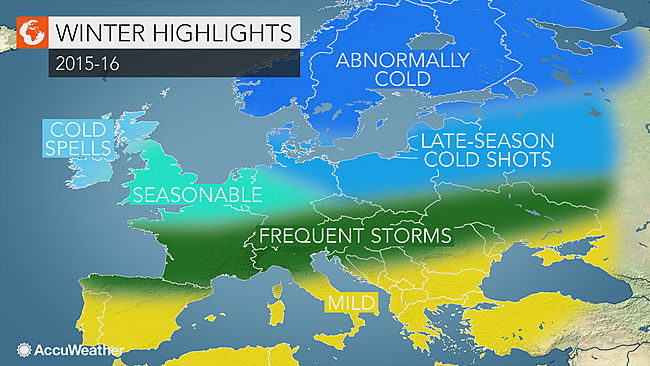
According to Accuweather, dominant storm tracks are forecast to prevail, moving west to east across Europe leading to a major contrast between cold air building across Scandinavia and mild air bellowed in the Mediterranean area. In contrary, areas from central France and northern Spain to the Alps are forecast to experience numerous powerful winter storms, while northern France and the majority of the United Kingdom is forecast to be spared the worst of winter’s power.

High pressure to the north of the United Kingdom is forecast prevail for the majority of the winter, resulting in an average winter for parts of northwestern Europe with stretches of calm weather and typical temperatures. This winter shouldn’t completely lack cold-air masses and powerful wind storms, but it is forecast to pass with near normal temperatures and a relatively comfortable winter. Through December, the greatest threat of damaging wind storms appear in the United Kingdom, Ireland, and northwest Europe, which is caused by storms pushing their way through the Atlantic into western Europe.

Ranging from England into northern France and western Germany are forecast experience relatively calm weather when the storm track moves its way southward. The bulk of the extremely cold weather will build over Scandinavia and unleash itself southward, limiting the amount of below-average cold weather that will reach northwest Europe. Ireland and Scotland are forecast to be exceptions though, where below-average water temperatures in the North Atlantic will lead to daily high temperatures to be below normal.

The cold air should continue to build over Scandinavia as the winter goes on, resulting in a relatively cold winter for Denmark and Germany eastward through Poland, Belarus, and the Baltic States. As the winter goes on, the cold air is forecast continue to push southward bringing frigid weather into Berlin, Warsaw, and Minsk. The second half of the winter season is forecast bring an increased threat of heavy snowfall due to the moisture in the Mediterranean and cold air pushing southward from Scandinavia. Wind storms should not be less worry sum this winter as the strongest ones continue to track in a southbound direction along with the less powerful ones heading towards the North Sea to the Baltic Sea in comparison to the previous seasons.

The strongest storm track for the upcoming winter season is forecast to feature Atlantic storm systems moving from northern Spain and southern France eastward through Northern Italy and the Alps prior to moving farther east across the northern Balkans and into Ukraine. This storm track is forecast to bring an elevated risk in flooding and wind storms in these areas. Moisture from the Mediterranean will fuel short durational heavy rainfall events for Italy and Balkan unlike the slow-moving storms that have been plentiful in the previous years.
“The high frequency of storms moving through the heart of Europe will favor above-normal snow in the Alps and a good season overall for skiers,” according to AccuWeather Senior Meteorologist Jason Nicholls.
The Alps are forecast to see frequent snowfall, but mild temperatures may cause skiing conditions to be subpar for the first half of the ski season. While low elevation snowfall is predicted to be abundant, the higher elevations such as the northern Dinaric Alps and Carpathian Mountains will experience frequent snowfall.

The primary storm track is forecast to be from France through the Alps and into Eastern Europe, resulting in a mild winter for the areas further south. Portugal, Spain, Italy, and the majority of the Balkan Peninsula will experience long spirts of above-average temperatures. Southern Spain and Portugal should experience a relatively dry winter with warm weather, while France and northern Spain will see reoccurring rounds of unsettled weather. Spain, southern France, and Italy are forecast be at an increased risk of severe thunderstorms due to the combination of warm air and moisture from the Mediterranean Sea. Along with that, extended periods of unseasonably warm weather should result in an increased number of severe thunderstorms in the southern region of Balkans.